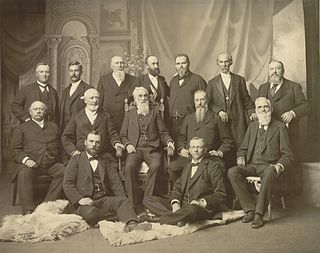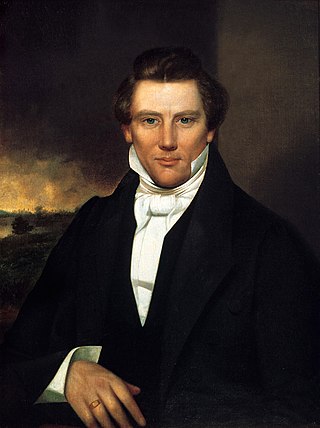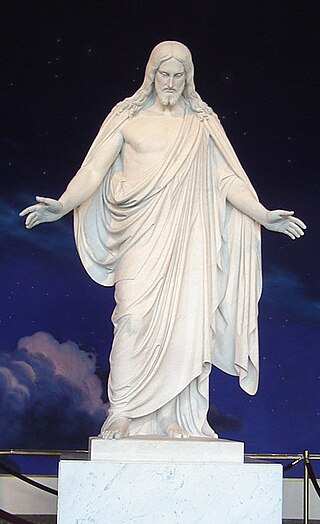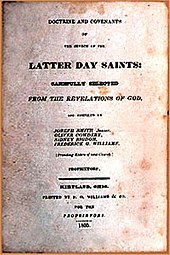In Mormonism, the restoration refers to a return of the authentic priesthood power, spiritual gifts, ordinances, living prophets and revelation of the primitive Church of Christ after a long period of apostasy. While in some contexts the term may also refer to the early history of Mormonism, in other contexts the term is used in a way to include the time that has elapsed from the church's earliest beginnings until the present day. Especially in the Church of Jesus Christ of Latter-day Saints "the restoration" is often used also as a term to encompass the corpus of religious messages from its general leaders down to the present.

In the Church of Jesus Christ of Latter-day Saints, the Quorum of the Twelve Apostles is one of the governing bodies in the church hierarchy. Members of the Quorum of the Twelve Apostles are apostles, with the calling to be prophets, seers, and revelators, evangelical ambassadors, and special witnesses of Jesus Christ.

Elizabeth Ann Smith Whitney was an early Latter Day Saint leader, and wife to Newel K. Whitney, another early Latter Day Saint leader. She went by her middle name, Ann.

Charles William Penrose was a member of the Quorum of the Twelve Apostles of the Church of Jesus Christ of Latter-day Saints from 1904 to 1911. Penrose was also a member of the First Presidency, serving as a counselor to church presidents Joseph F. Smith and Heber J. Grant from 1911 until his death.

The Kirtland Temple is the first temple built by adherents of the Latter Day Saint movement, located in Kirtland, Ohio, and dedicated in March 1836. Joseph Smith, the movement's founder, directed the construction following a series of reported revelations, and the temple showcases a blend of Federal, Greek Revival, and Gothic Revival architectural styles. It was added to the National Register of Historic Places in 1969 and named a National Historic Landmark in 1977. Prior to March 5, 2024, the temple was owned and operated by Community of Christ for over a century before ownership transferred to the Church of Jesus Christ of Latter-day Saints.

William Earl McLellin was an early leader in the Latter Day Saint movement. One of the original members of the Quorum of the Twelve Apostles, McLellin later broke with church founder Joseph Smith.

Zion's Camp was an expedition of Latter Day Saints led by Joseph Smith, from Kirtland, Ohio, to Clay County, Missouri, during May and June 1834 in an unsuccessful attempt to regain land from which the Saints had been expelled by non-Mormon settlers. In Latter Day Saint belief, this land is destined to become a city of Zion, the center of the millennial kingdom; and Smith dictated a command from God ordering him to lead his church like a modern Moses to redeem Zion "by power, and with a stretched-out arm."

William Wines Phelps was an early leader of the Latter Day Saint movement. He printed the first edition of the Book of Commandments that became a standard work of the church and wrote numerous hymns, some of which are included in the current version of the Church of Jesus Christ of Latter-day Saints' hymnal. He was at times both close to and at odds with church leadership. He testified against Joseph Smith, providing evidence that helped persuade authorities to arrest Smith. He was excommunicated three times and rejoined the church each time. He was a ghostwriter for Smith. Phelps was called by Smith to serve as assistant president of the church in Missouri and as a member of the Council of Fifty. After Smith's death, Phelps supported Brigham Young, who was the church's new president.

In the Latter Day Saint movement, a temple is a building dedicated to being a house of God and is reserved for special forms of worship. A temple differs from a church meetinghouse, which is used for weekly worship services. Temples have been a significant part of the Latter Day Saint movement since early in its inception. Today, temples are operated by several Latter Day Saint denominations. The most prolific builder of temples of the Latter Day Saint movement is the Church of Jesus Christ of Latter-day Saints. The LDS Church has 350 temples in various phases, which includes 195 dedicated temples, 49 under construction, and 106 others announced. Several others within the movement have built or attempted to build temples. The Community of Christ operates one temple in the United States, which is open to the public and used for worship services, performances, and religious education. Other denominations with temples are the Apostolic United Brethren, the Church of Christ, the Fundamentalist Church of Jesus Christ of Latter-Day Saints, and the Righteous Branch of the Church of Jesus Christ of Latter-day Saints.
Within the Latter Day Saint movement, Zion is often used to connote an association of the righteous. This association would practice a form of communitarian economics, called the United Order, which were meant to ensure that all members maintained an acceptable quality of life, class distinctions were minimized, and group unity achieved.

Oliver Granger was an early leader in the Latter Day Saint movement. He was the subject of one of the prophecies of movement founder Joseph Smith.

John Murdock Jr. was an early convert to the Latter Day Saint movement and was a missionary for the Church of Jesus Christ of Latter-day Saints. Mentioned twice in the Doctrine and Covenants, he devoted most of his life to full-time missionary service for the LDS Church. He was the first mission president for the LDS Church in Australia where he oversaw the official organization of the church in the country and its early growth. A compatriot of Joseph Smith, Murdock attended School of the Prophets and participated in Zion's Camp. After the death of his first wife in childbirth, Joseph and Emma Smith adopted his infant twins. Julia Murdock Smith, who survived to adulthood, was the eldest child and only daughter of the Smiths.

Zebedee Coltrin was a Mormon pioneer and a general authority in the Church of Jesus Christ of Latter-day Saints from 1835 to 1837. He served in later years as a patriarch in the church, from 1873 until his death.
Sylvester Marshall Smith was an early leader in the Latter Day Saint movement and one of the inaugural seven Presidents of the Seventy.
Steven Craig Harper is a professor of church history and doctrine at Brigham Young University. He was a historian for the Church History Department of the Church of Jesus Christ of Latter-day Saints. From 2019, he is the Editor-in-Chief of BYU Studies Quarterly.
In the theology of the Latter Day Saint movement, an endowment refers to a gift of "power from on high", typically associated with the ordinances performed in Latter Day Saint temples. The purpose and meaning of the endowment varied during the life of movement founder Joseph Smith. The term has referred to many such gifts of heavenly power, including the confirmation ritual, the institution of the High Priesthood in 1831, events and rituals occurring in the Kirtland Temple in the mid-1830s, and an elaborate ritual performed in the Nauvoo Temple in the 1840s.

This is a chronology of Mormonism. In the late 1820s, Joseph Smith, founder of the Latter Day Saint movement, announced that an angel had given him a set of golden plates engraved with a chronicle of ancient American peoples, which he had a unique gift to translate. In 1830, he published the resulting narratives as the Book of Mormon and founded the Church of Christ in western New York, claiming it to be a restoration of early Christianity.

The following outline is provided as an overview of and a topical guide to the Church of Jesus Christ of Latter-day Saints.













